HNC Unit 6: Managing a Successful Business Project - Gender Diversity
VerifiedAdded on 2022/08/15
|18
|5986
|11
Project
AI Summary
This project examines the multifaceted impact of gender diversity on workplace productivity, addressing the challenges and opportunities present in modern organizations. The project begins with an introduction that highlights the significance of gender diversity and the prevalence of inequality despite legal frameworks. It reviews existing literature, exploring how gender diversity affects productivity, decision-making, and organizational attractiveness. The methodology section details a qualitative study design utilizing semi-structured interviews to gather insights from a diverse group of participants, including managers and employees, focusing on their perspectives on gender diversity and its effects on productivity. The findings reveal key themes, including gender inequality, pay gaps, work-life balance issues, industry-specific biases, and sexual harassment. The project then discusses the implications of these challenges and proposes strategies to address them, emphasizing the importance of managing diversity and promoting equality to enhance productivity and create a more inclusive work environment. The project concludes by summarizing the key findings and reinforcing the importance of gender diversity for organizational success.

Effect of Gender Diversity on Productivity in the Workplace 1
EFFECT OF GENDER DIVERSITY ON PRODUCTIVITY IN THE WORKPLACE
by [Name]
Course
Professor’s Name
Institution
Location of Institution
Date
EFFECT OF GENDER DIVERSITY ON PRODUCTIVITY IN THE WORKPLACE
by [Name]
Course
Professor’s Name
Institution
Location of Institution
Date
Paraphrase This Document
Need a fresh take? Get an instant paraphrase of this document with our AI Paraphraser
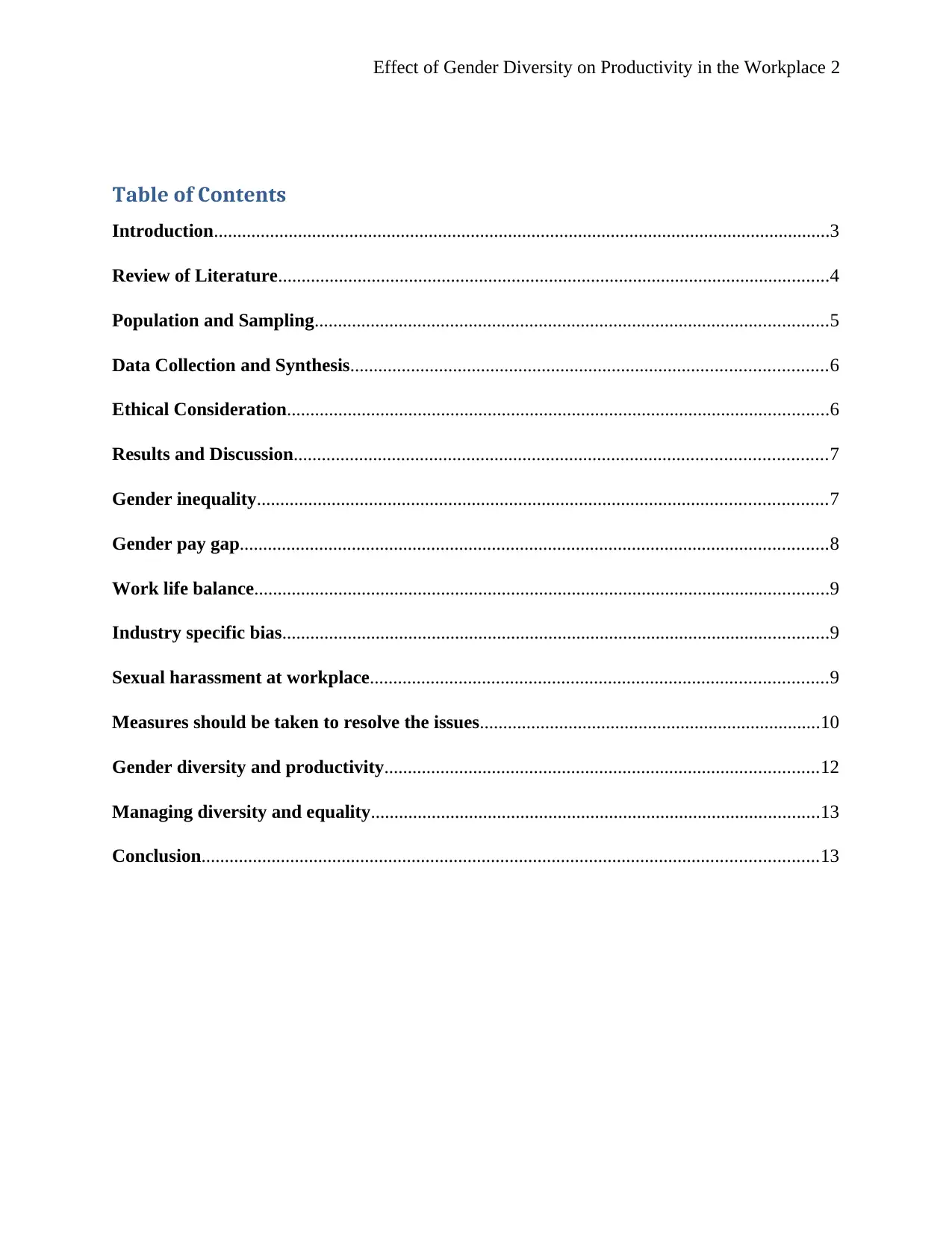
Effect of Gender Diversity on Productivity in the Workplace 2
Table of Contents
Introduction....................................................................................................................................3
Review of Literature......................................................................................................................4
Population and Sampling..............................................................................................................5
Data Collection and Synthesis......................................................................................................6
Ethical Consideration....................................................................................................................6
Results and Discussion..................................................................................................................7
Gender inequality..........................................................................................................................7
Gender pay gap..............................................................................................................................8
Work life balance...........................................................................................................................9
Industry specific bias.....................................................................................................................9
Sexual harassment at workplace..................................................................................................9
Measures should be taken to resolve the issues.........................................................................10
Gender diversity and productivity.............................................................................................12
Managing diversity and equality................................................................................................13
Conclusion....................................................................................................................................13
Table of Contents
Introduction....................................................................................................................................3
Review of Literature......................................................................................................................4
Population and Sampling..............................................................................................................5
Data Collection and Synthesis......................................................................................................6
Ethical Consideration....................................................................................................................6
Results and Discussion..................................................................................................................7
Gender inequality..........................................................................................................................7
Gender pay gap..............................................................................................................................8
Work life balance...........................................................................................................................9
Industry specific bias.....................................................................................................................9
Sexual harassment at workplace..................................................................................................9
Measures should be taken to resolve the issues.........................................................................10
Gender diversity and productivity.............................................................................................12
Managing diversity and equality................................................................................................13
Conclusion....................................................................................................................................13

Effect of Gender Diversity on Productivity in the Workplace 3
Introduction
In this assignment, an analysis will be done over the issues related to gender diversity at
workplaces. Various issues related to gender diversity arises because of the diversified
background of employees. Most of the companies are facing many challenges because of their
diversified workforce. Workplace diversity can be defined as difference in gender, age, physical
appearance, race, religion and geographical areas. However many legislative laws have been
made by the government in order to resolve the diversity related issues but still the organisation
have to maintain a proper diversity inclusion strategies to overcome the challenges arises due to
diversity issues. In this assignment, focus will be provided over challenges and diversity
inclusion strategies.
The major objectives of this assignment are to know about the real position of gender
discrimination at the workplace. The aim of this assignment is to assess the condition of women
at the workplaces. This study helps in improving the current position of women especially at the
workplaces. The analysis of laws also leads towards making an understanding related to the most
suitable behaviour for all working employees at the workplaces. This assignment would be very
beneficial in resolving the gender diversity issues at the workplace (Fuhl, 2020).
In spite of the numerous legislations and recognition by many organisations on the need for
diversity and equality at the workplace, inequality is still prevalent in many institutions. The
reason behind this is that managing equality and diversity requires more than laws and
regulations to include specific initiatives from the individual organisation (Sharma, 2016). Issues
and challenges relating to gender diversity in the workplace and how such problems affect
performance have been discussed intensively. While some scholars believe diversity leads to
high productivity, others are of a contrary opinion. The aim of this study was to examine issues
associated with gender diversity and how such issues affect productivity (JL Cundiff, 2016). To
cover the research gap, this study sought to find universal ways of dealing with the challenges so
as to boost productivity regardless of the industry, country, or sector. The research questions of
the study were as follows:
1. What challenges do women face in the workplace?
2. What ways can an organisation implement to deal with gender diversity at the
workplace?
Introduction
In this assignment, an analysis will be done over the issues related to gender diversity at
workplaces. Various issues related to gender diversity arises because of the diversified
background of employees. Most of the companies are facing many challenges because of their
diversified workforce. Workplace diversity can be defined as difference in gender, age, physical
appearance, race, religion and geographical areas. However many legislative laws have been
made by the government in order to resolve the diversity related issues but still the organisation
have to maintain a proper diversity inclusion strategies to overcome the challenges arises due to
diversity issues. In this assignment, focus will be provided over challenges and diversity
inclusion strategies.
The major objectives of this assignment are to know about the real position of gender
discrimination at the workplace. The aim of this assignment is to assess the condition of women
at the workplaces. This study helps in improving the current position of women especially at the
workplaces. The analysis of laws also leads towards making an understanding related to the most
suitable behaviour for all working employees at the workplaces. This assignment would be very
beneficial in resolving the gender diversity issues at the workplace (Fuhl, 2020).
In spite of the numerous legislations and recognition by many organisations on the need for
diversity and equality at the workplace, inequality is still prevalent in many institutions. The
reason behind this is that managing equality and diversity requires more than laws and
regulations to include specific initiatives from the individual organisation (Sharma, 2016). Issues
and challenges relating to gender diversity in the workplace and how such problems affect
performance have been discussed intensively. While some scholars believe diversity leads to
high productivity, others are of a contrary opinion. The aim of this study was to examine issues
associated with gender diversity and how such issues affect productivity (JL Cundiff, 2016). To
cover the research gap, this study sought to find universal ways of dealing with the challenges so
as to boost productivity regardless of the industry, country, or sector. The research questions of
the study were as follows:
1. What challenges do women face in the workplace?
2. What ways can an organisation implement to deal with gender diversity at the
workplace?
⊘ This is a preview!⊘
Do you want full access?
Subscribe today to unlock all pages.

Trusted by 1+ million students worldwide
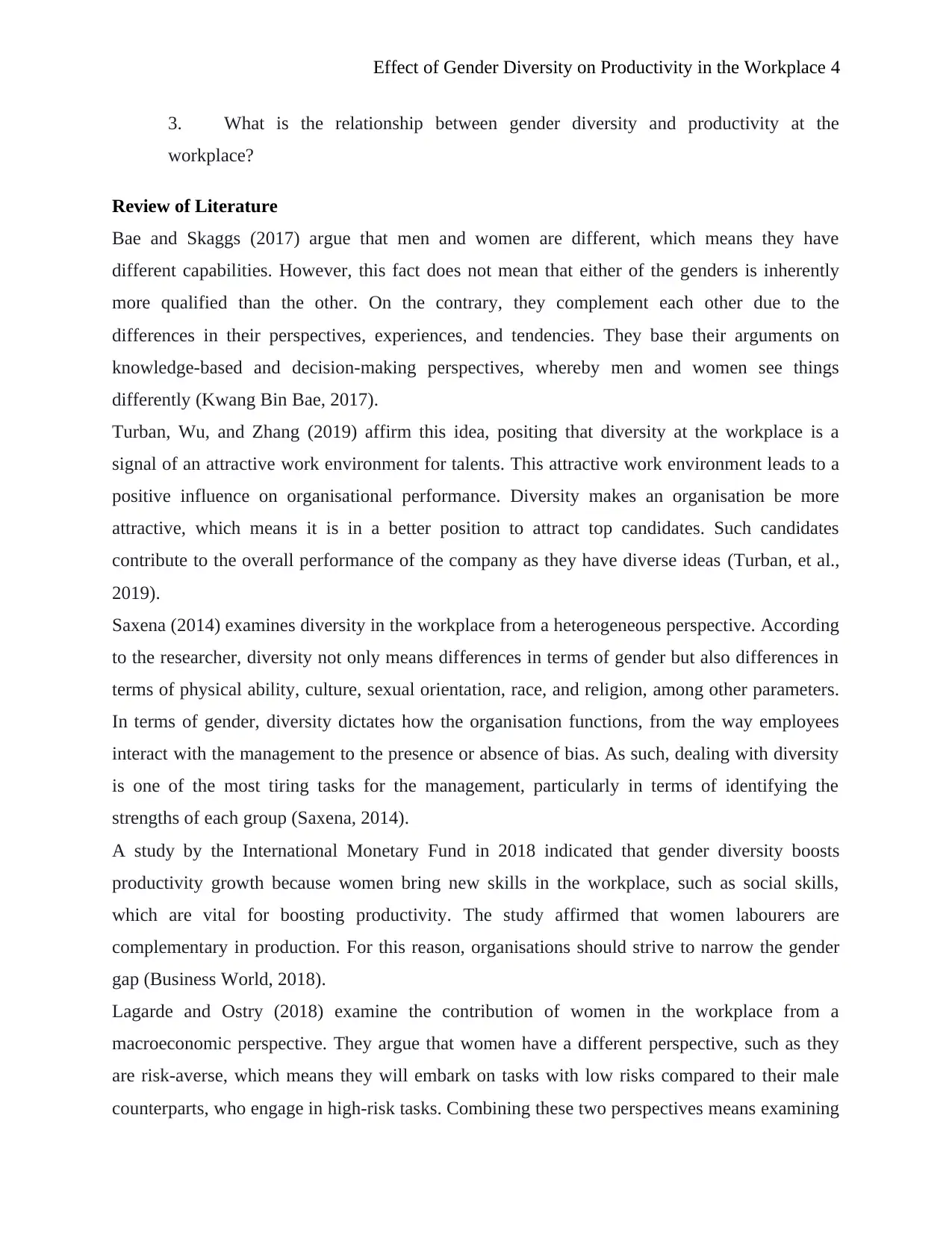
Effect of Gender Diversity on Productivity in the Workplace 4
3. What is the relationship between gender diversity and productivity at the
workplace?
Review of Literature
Bae and Skaggs (2017) argue that men and women are different, which means they have
different capabilities. However, this fact does not mean that either of the genders is inherently
more qualified than the other. On the contrary, they complement each other due to the
differences in their perspectives, experiences, and tendencies. They base their arguments on
knowledge-based and decision-making perspectives, whereby men and women see things
differently (Kwang Bin Bae, 2017).
Turban, Wu, and Zhang (2019) affirm this idea, positing that diversity at the workplace is a
signal of an attractive work environment for talents. This attractive work environment leads to a
positive influence on organisational performance. Diversity makes an organisation be more
attractive, which means it is in a better position to attract top candidates. Such candidates
contribute to the overall performance of the company as they have diverse ideas (Turban, et al.,
2019).
Saxena (2014) examines diversity in the workplace from a heterogeneous perspective. According
to the researcher, diversity not only means differences in terms of gender but also differences in
terms of physical ability, culture, sexual orientation, race, and religion, among other parameters.
In terms of gender, diversity dictates how the organisation functions, from the way employees
interact with the management to the presence or absence of bias. As such, dealing with diversity
is one of the most tiring tasks for the management, particularly in terms of identifying the
strengths of each group (Saxena, 2014).
A study by the International Monetary Fund in 2018 indicated that gender diversity boosts
productivity growth because women bring new skills in the workplace, such as social skills,
which are vital for boosting productivity. The study affirmed that women labourers are
complementary in production. For this reason, organisations should strive to narrow the gender
gap (Business World, 2018).
Lagarde and Ostry (2018) examine the contribution of women in the workplace from a
macroeconomic perspective. They argue that women have a different perspective, such as they
are risk-averse, which means they will embark on tasks with low risks compared to their male
counterparts, who engage in high-risk tasks. Combining these two perspectives means examining
3. What is the relationship between gender diversity and productivity at the
workplace?
Review of Literature
Bae and Skaggs (2017) argue that men and women are different, which means they have
different capabilities. However, this fact does not mean that either of the genders is inherently
more qualified than the other. On the contrary, they complement each other due to the
differences in their perspectives, experiences, and tendencies. They base their arguments on
knowledge-based and decision-making perspectives, whereby men and women see things
differently (Kwang Bin Bae, 2017).
Turban, Wu, and Zhang (2019) affirm this idea, positing that diversity at the workplace is a
signal of an attractive work environment for talents. This attractive work environment leads to a
positive influence on organisational performance. Diversity makes an organisation be more
attractive, which means it is in a better position to attract top candidates. Such candidates
contribute to the overall performance of the company as they have diverse ideas (Turban, et al.,
2019).
Saxena (2014) examines diversity in the workplace from a heterogeneous perspective. According
to the researcher, diversity not only means differences in terms of gender but also differences in
terms of physical ability, culture, sexual orientation, race, and religion, among other parameters.
In terms of gender, diversity dictates how the organisation functions, from the way employees
interact with the management to the presence or absence of bias. As such, dealing with diversity
is one of the most tiring tasks for the management, particularly in terms of identifying the
strengths of each group (Saxena, 2014).
A study by the International Monetary Fund in 2018 indicated that gender diversity boosts
productivity growth because women bring new skills in the workplace, such as social skills,
which are vital for boosting productivity. The study affirmed that women labourers are
complementary in production. For this reason, organisations should strive to narrow the gender
gap (Business World, 2018).
Lagarde and Ostry (2018) examine the contribution of women in the workplace from a
macroeconomic perspective. They argue that women have a different perspective, such as they
are risk-averse, which means they will embark on tasks with low risks compared to their male
counterparts, who engage in high-risk tasks. Combining these two perspectives means examining
Paraphrase This Document
Need a fresh take? Get an instant paraphrase of this document with our AI Paraphraser
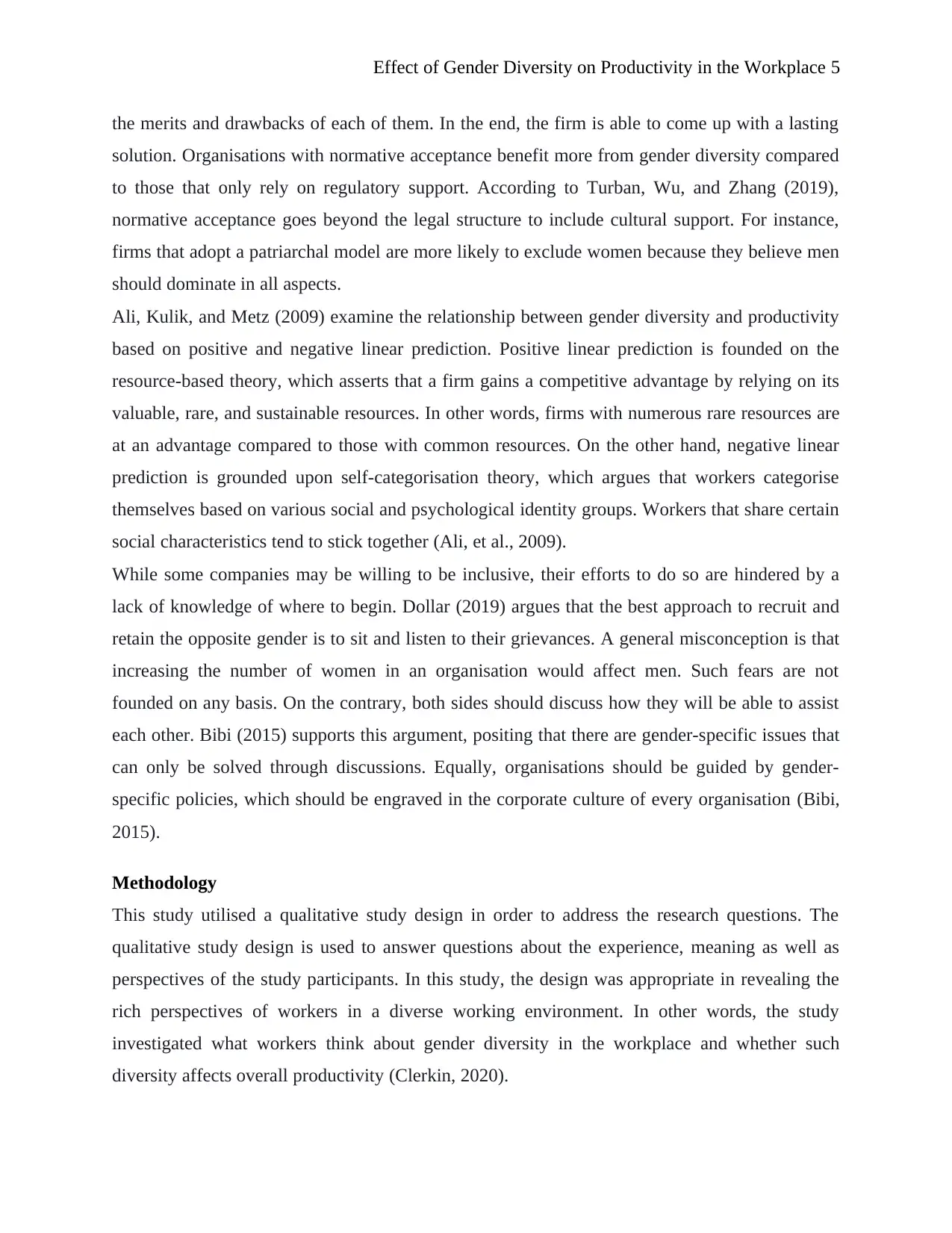
Effect of Gender Diversity on Productivity in the Workplace 5
the merits and drawbacks of each of them. In the end, the firm is able to come up with a lasting
solution. Organisations with normative acceptance benefit more from gender diversity compared
to those that only rely on regulatory support. According to Turban, Wu, and Zhang (2019),
normative acceptance goes beyond the legal structure to include cultural support. For instance,
firms that adopt a patriarchal model are more likely to exclude women because they believe men
should dominate in all aspects.
Ali, Kulik, and Metz (2009) examine the relationship between gender diversity and productivity
based on positive and negative linear prediction. Positive linear prediction is founded on the
resource-based theory, which asserts that a firm gains a competitive advantage by relying on its
valuable, rare, and sustainable resources. In other words, firms with numerous rare resources are
at an advantage compared to those with common resources. On the other hand, negative linear
prediction is grounded upon self-categorisation theory, which argues that workers categorise
themselves based on various social and psychological identity groups. Workers that share certain
social characteristics tend to stick together (Ali, et al., 2009).
While some companies may be willing to be inclusive, their efforts to do so are hindered by a
lack of knowledge of where to begin. Dollar (2019) argues that the best approach to recruit and
retain the opposite gender is to sit and listen to their grievances. A general misconception is that
increasing the number of women in an organisation would affect men. Such fears are not
founded on any basis. On the contrary, both sides should discuss how they will be able to assist
each other. Bibi (2015) supports this argument, positing that there are gender-specific issues that
can only be solved through discussions. Equally, organisations should be guided by gender-
specific policies, which should be engraved in the corporate culture of every organisation (Bibi,
2015).
Methodology
This study utilised a qualitative study design in order to address the research questions. The
qualitative study design is used to answer questions about the experience, meaning as well as
perspectives of the study participants. In this study, the design was appropriate in revealing the
rich perspectives of workers in a diverse working environment. In other words, the study
investigated what workers think about gender diversity in the workplace and whether such
diversity affects overall productivity (Clerkin, 2020).
the merits and drawbacks of each of them. In the end, the firm is able to come up with a lasting
solution. Organisations with normative acceptance benefit more from gender diversity compared
to those that only rely on regulatory support. According to Turban, Wu, and Zhang (2019),
normative acceptance goes beyond the legal structure to include cultural support. For instance,
firms that adopt a patriarchal model are more likely to exclude women because they believe men
should dominate in all aspects.
Ali, Kulik, and Metz (2009) examine the relationship between gender diversity and productivity
based on positive and negative linear prediction. Positive linear prediction is founded on the
resource-based theory, which asserts that a firm gains a competitive advantage by relying on its
valuable, rare, and sustainable resources. In other words, firms with numerous rare resources are
at an advantage compared to those with common resources. On the other hand, negative linear
prediction is grounded upon self-categorisation theory, which argues that workers categorise
themselves based on various social and psychological identity groups. Workers that share certain
social characteristics tend to stick together (Ali, et al., 2009).
While some companies may be willing to be inclusive, their efforts to do so are hindered by a
lack of knowledge of where to begin. Dollar (2019) argues that the best approach to recruit and
retain the opposite gender is to sit and listen to their grievances. A general misconception is that
increasing the number of women in an organisation would affect men. Such fears are not
founded on any basis. On the contrary, both sides should discuss how they will be able to assist
each other. Bibi (2015) supports this argument, positing that there are gender-specific issues that
can only be solved through discussions. Equally, organisations should be guided by gender-
specific policies, which should be engraved in the corporate culture of every organisation (Bibi,
2015).
Methodology
This study utilised a qualitative study design in order to address the research questions. The
qualitative study design is used to answer questions about the experience, meaning as well as
perspectives of the study participants. In this study, the design was appropriate in revealing the
rich perspectives of workers in a diverse working environment. In other words, the study
investigated what workers think about gender diversity in the workplace and whether such
diversity affects overall productivity (Clerkin, 2020).
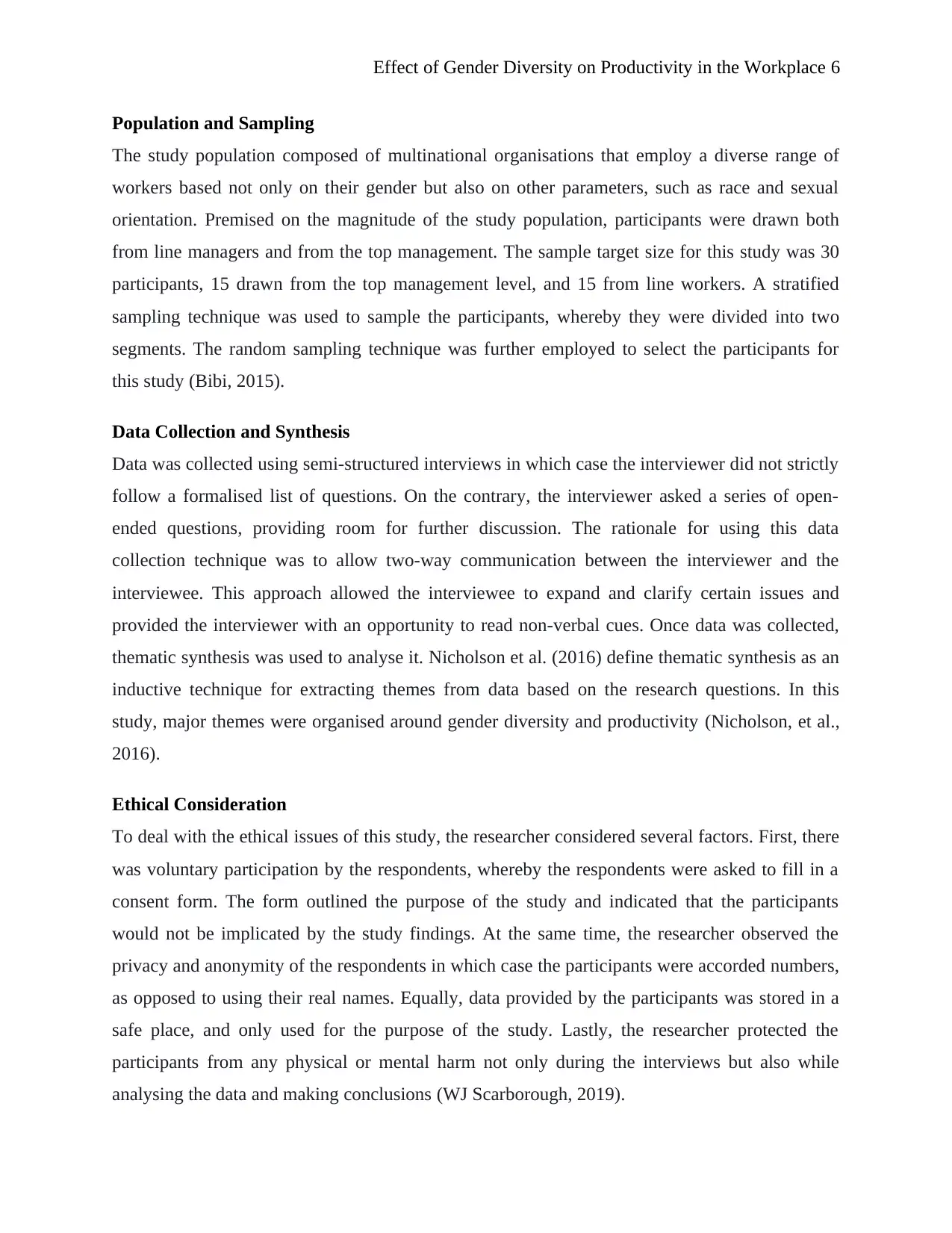
Effect of Gender Diversity on Productivity in the Workplace 6
Population and Sampling
The study population composed of multinational organisations that employ a diverse range of
workers based not only on their gender but also on other parameters, such as race and sexual
orientation. Premised on the magnitude of the study population, participants were drawn both
from line managers and from the top management. The sample target size for this study was 30
participants, 15 drawn from the top management level, and 15 from line workers. A stratified
sampling technique was used to sample the participants, whereby they were divided into two
segments. The random sampling technique was further employed to select the participants for
this study (Bibi, 2015).
Data Collection and Synthesis
Data was collected using semi-structured interviews in which case the interviewer did not strictly
follow a formalised list of questions. On the contrary, the interviewer asked a series of open-
ended questions, providing room for further discussion. The rationale for using this data
collection technique was to allow two-way communication between the interviewer and the
interviewee. This approach allowed the interviewee to expand and clarify certain issues and
provided the interviewer with an opportunity to read non-verbal cues. Once data was collected,
thematic synthesis was used to analyse it. Nicholson et al. (2016) define thematic synthesis as an
inductive technique for extracting themes from data based on the research questions. In this
study, major themes were organised around gender diversity and productivity (Nicholson, et al.,
2016).
Ethical Consideration
To deal with the ethical issues of this study, the researcher considered several factors. First, there
was voluntary participation by the respondents, whereby the respondents were asked to fill in a
consent form. The form outlined the purpose of the study and indicated that the participants
would not be implicated by the study findings. At the same time, the researcher observed the
privacy and anonymity of the respondents in which case the participants were accorded numbers,
as opposed to using their real names. Equally, data provided by the participants was stored in a
safe place, and only used for the purpose of the study. Lastly, the researcher protected the
participants from any physical or mental harm not only during the interviews but also while
analysing the data and making conclusions (WJ Scarborough, 2019).
Population and Sampling
The study population composed of multinational organisations that employ a diverse range of
workers based not only on their gender but also on other parameters, such as race and sexual
orientation. Premised on the magnitude of the study population, participants were drawn both
from line managers and from the top management. The sample target size for this study was 30
participants, 15 drawn from the top management level, and 15 from line workers. A stratified
sampling technique was used to sample the participants, whereby they were divided into two
segments. The random sampling technique was further employed to select the participants for
this study (Bibi, 2015).
Data Collection and Synthesis
Data was collected using semi-structured interviews in which case the interviewer did not strictly
follow a formalised list of questions. On the contrary, the interviewer asked a series of open-
ended questions, providing room for further discussion. The rationale for using this data
collection technique was to allow two-way communication between the interviewer and the
interviewee. This approach allowed the interviewee to expand and clarify certain issues and
provided the interviewer with an opportunity to read non-verbal cues. Once data was collected,
thematic synthesis was used to analyse it. Nicholson et al. (2016) define thematic synthesis as an
inductive technique for extracting themes from data based on the research questions. In this
study, major themes were organised around gender diversity and productivity (Nicholson, et al.,
2016).
Ethical Consideration
To deal with the ethical issues of this study, the researcher considered several factors. First, there
was voluntary participation by the respondents, whereby the respondents were asked to fill in a
consent form. The form outlined the purpose of the study and indicated that the participants
would not be implicated by the study findings. At the same time, the researcher observed the
privacy and anonymity of the respondents in which case the participants were accorded numbers,
as opposed to using their real names. Equally, data provided by the participants was stored in a
safe place, and only used for the purpose of the study. Lastly, the researcher protected the
participants from any physical or mental harm not only during the interviews but also while
analysing the data and making conclusions (WJ Scarborough, 2019).
⊘ This is a preview!⊘
Do you want full access?
Subscribe today to unlock all pages.

Trusted by 1+ million students worldwide
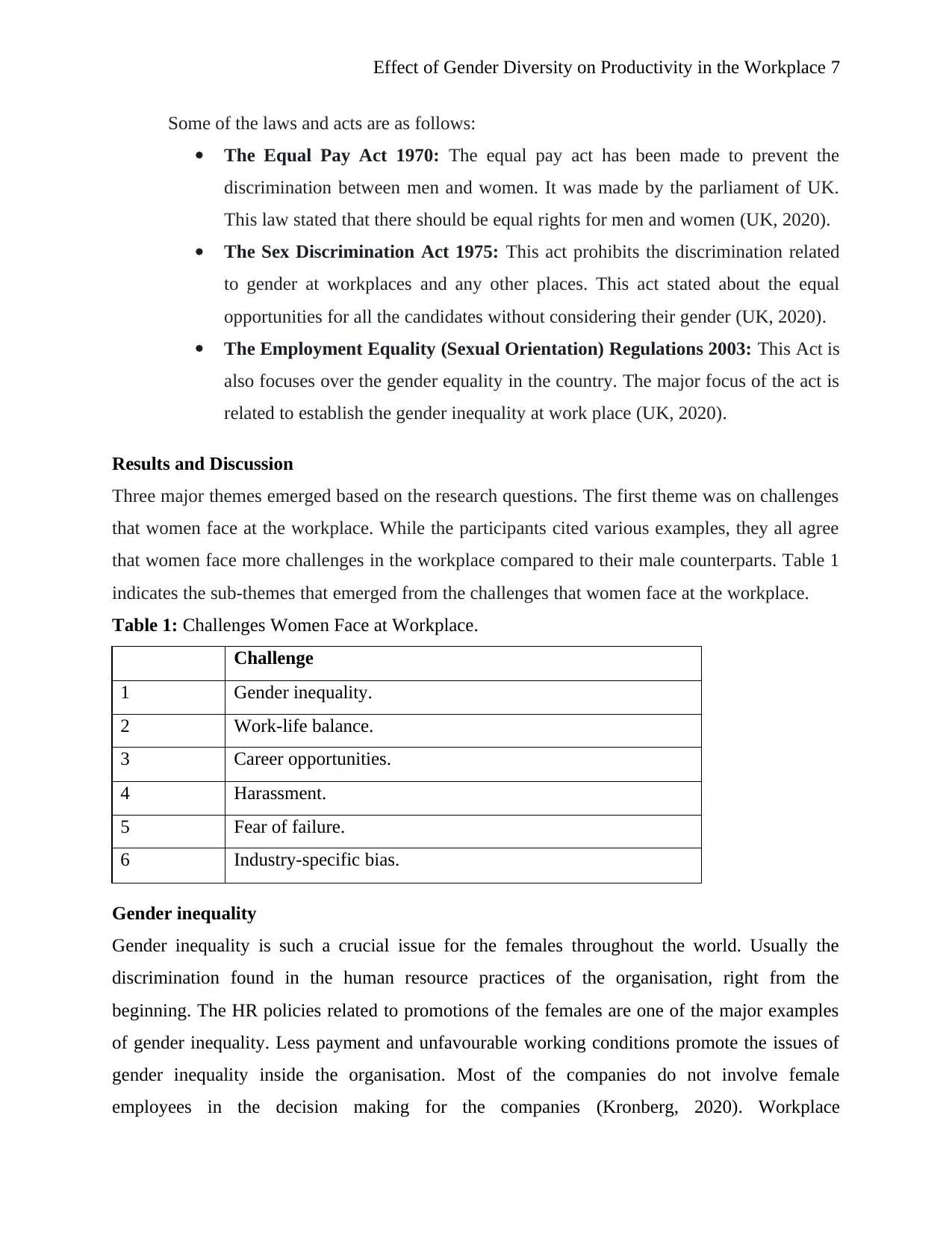
Effect of Gender Diversity on Productivity in the Workplace 7
Some of the laws and acts are as follows:
The Equal Pay Act 1970: The equal pay act has been made to prevent the
discrimination between men and women. It was made by the parliament of UK.
This law stated that there should be equal rights for men and women (UK, 2020).
The Sex Discrimination Act 1975: This act prohibits the discrimination related
to gender at workplaces and any other places. This act stated about the equal
opportunities for all the candidates without considering their gender (UK, 2020).
The Employment Equality (Sexual Orientation) Regulations 2003: This Act is
also focuses over the gender equality in the country. The major focus of the act is
related to establish the gender inequality at work place (UK, 2020).
Results and Discussion
Three major themes emerged based on the research questions. The first theme was on challenges
that women face at the workplace. While the participants cited various examples, they all agree
that women face more challenges in the workplace compared to their male counterparts. Table 1
indicates the sub-themes that emerged from the challenges that women face at the workplace.
Table 1: Challenges Women Face at Workplace.
Challenge
1 Gender inequality.
2 Work-life balance.
3 Career opportunities.
4 Harassment.
5 Fear of failure.
6 Industry-specific bias.
Gender inequality
Gender inequality is such a crucial issue for the females throughout the world. Usually the
discrimination found in the human resource practices of the organisation, right from the
beginning. The HR policies related to promotions of the females are one of the major examples
of gender inequality. Less payment and unfavourable working conditions promote the issues of
gender inequality inside the organisation. Most of the companies do not involve female
employees in the decision making for the companies (Kronberg, 2020). Workplace
Some of the laws and acts are as follows:
The Equal Pay Act 1970: The equal pay act has been made to prevent the
discrimination between men and women. It was made by the parliament of UK.
This law stated that there should be equal rights for men and women (UK, 2020).
The Sex Discrimination Act 1975: This act prohibits the discrimination related
to gender at workplaces and any other places. This act stated about the equal
opportunities for all the candidates without considering their gender (UK, 2020).
The Employment Equality (Sexual Orientation) Regulations 2003: This Act is
also focuses over the gender equality in the country. The major focus of the act is
related to establish the gender inequality at work place (UK, 2020).
Results and Discussion
Three major themes emerged based on the research questions. The first theme was on challenges
that women face at the workplace. While the participants cited various examples, they all agree
that women face more challenges in the workplace compared to their male counterparts. Table 1
indicates the sub-themes that emerged from the challenges that women face at the workplace.
Table 1: Challenges Women Face at Workplace.
Challenge
1 Gender inequality.
2 Work-life balance.
3 Career opportunities.
4 Harassment.
5 Fear of failure.
6 Industry-specific bias.
Gender inequality
Gender inequality is such a crucial issue for the females throughout the world. Usually the
discrimination found in the human resource practices of the organisation, right from the
beginning. The HR policies related to promotions of the females are one of the major examples
of gender inequality. Less payment and unfavourable working conditions promote the issues of
gender inequality inside the organisation. Most of the companies do not involve female
employees in the decision making for the companies (Kronberg, 2020). Workplace
Paraphrase This Document
Need a fresh take? Get an instant paraphrase of this document with our AI Paraphraser
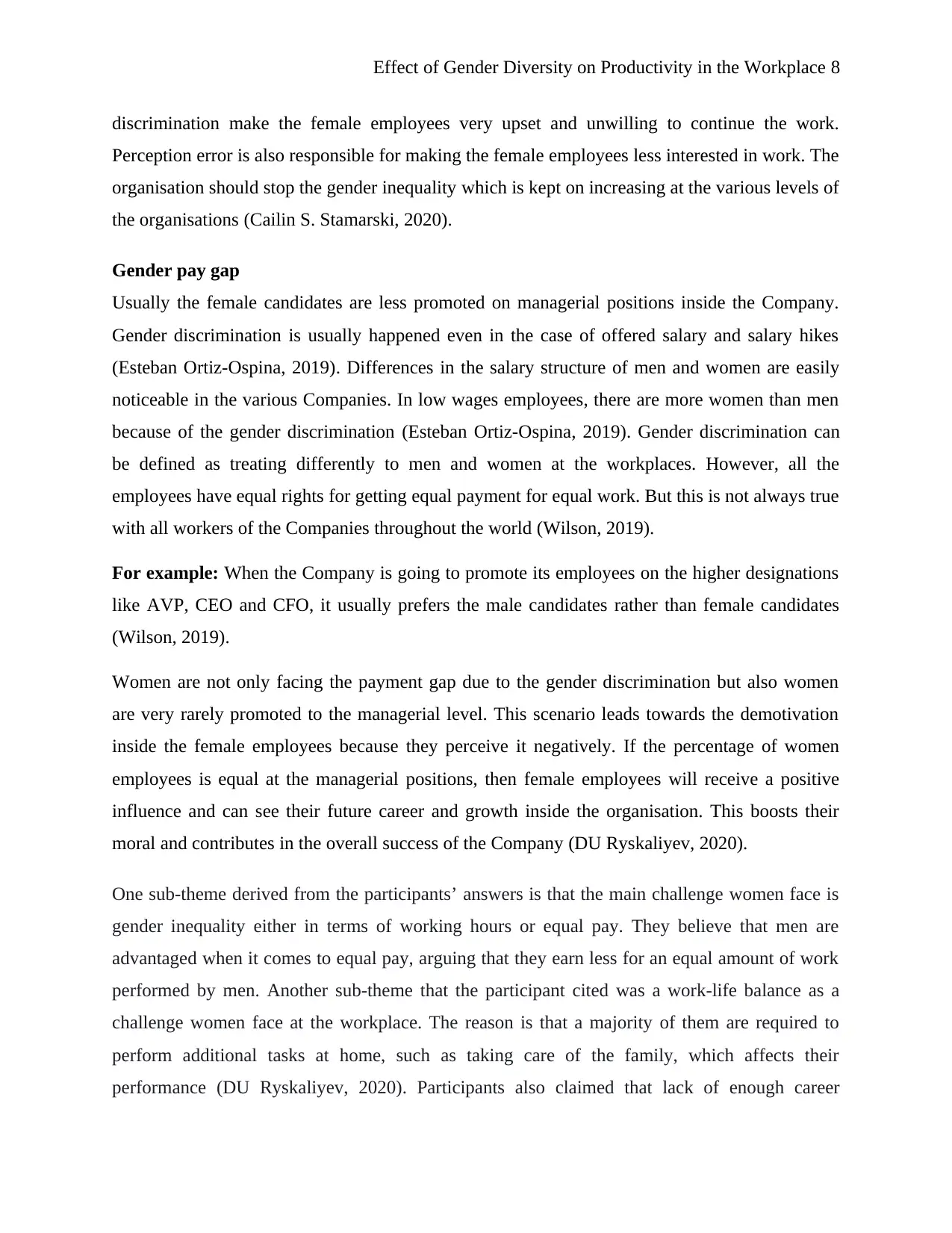
Effect of Gender Diversity on Productivity in the Workplace 8
discrimination make the female employees very upset and unwilling to continue the work.
Perception error is also responsible for making the female employees less interested in work. The
organisation should stop the gender inequality which is kept on increasing at the various levels of
the organisations (Cailin S. Stamarski, 2020).
Gender pay gap
Usually the female candidates are less promoted on managerial positions inside the Company.
Gender discrimination is usually happened even in the case of offered salary and salary hikes
(Esteban Ortiz-Ospina, 2019). Differences in the salary structure of men and women are easily
noticeable in the various Companies. In low wages employees, there are more women than men
because of the gender discrimination (Esteban Ortiz-Ospina, 2019). Gender discrimination can
be defined as treating differently to men and women at the workplaces. However, all the
employees have equal rights for getting equal payment for equal work. But this is not always true
with all workers of the Companies throughout the world (Wilson, 2019).
For example: When the Company is going to promote its employees on the higher designations
like AVP, CEO and CFO, it usually prefers the male candidates rather than female candidates
(Wilson, 2019).
Women are not only facing the payment gap due to the gender discrimination but also women
are very rarely promoted to the managerial level. This scenario leads towards the demotivation
inside the female employees because they perceive it negatively. If the percentage of women
employees is equal at the managerial positions, then female employees will receive a positive
influence and can see their future career and growth inside the organisation. This boosts their
moral and contributes in the overall success of the Company (DU Ryskaliyev, 2020).
One sub-theme derived from the participants’ answers is that the main challenge women face is
gender inequality either in terms of working hours or equal pay. They believe that men are
advantaged when it comes to equal pay, arguing that they earn less for an equal amount of work
performed by men. Another sub-theme that the participant cited was a work-life balance as a
challenge women face at the workplace. The reason is that a majority of them are required to
perform additional tasks at home, such as taking care of the family, which affects their
performance (DU Ryskaliyev, 2020). Participants also claimed that lack of enough career
discrimination make the female employees very upset and unwilling to continue the work.
Perception error is also responsible for making the female employees less interested in work. The
organisation should stop the gender inequality which is kept on increasing at the various levels of
the organisations (Cailin S. Stamarski, 2020).
Gender pay gap
Usually the female candidates are less promoted on managerial positions inside the Company.
Gender discrimination is usually happened even in the case of offered salary and salary hikes
(Esteban Ortiz-Ospina, 2019). Differences in the salary structure of men and women are easily
noticeable in the various Companies. In low wages employees, there are more women than men
because of the gender discrimination (Esteban Ortiz-Ospina, 2019). Gender discrimination can
be defined as treating differently to men and women at the workplaces. However, all the
employees have equal rights for getting equal payment for equal work. But this is not always true
with all workers of the Companies throughout the world (Wilson, 2019).
For example: When the Company is going to promote its employees on the higher designations
like AVP, CEO and CFO, it usually prefers the male candidates rather than female candidates
(Wilson, 2019).
Women are not only facing the payment gap due to the gender discrimination but also women
are very rarely promoted to the managerial level. This scenario leads towards the demotivation
inside the female employees because they perceive it negatively. If the percentage of women
employees is equal at the managerial positions, then female employees will receive a positive
influence and can see their future career and growth inside the organisation. This boosts their
moral and contributes in the overall success of the Company (DU Ryskaliyev, 2020).
One sub-theme derived from the participants’ answers is that the main challenge women face is
gender inequality either in terms of working hours or equal pay. They believe that men are
advantaged when it comes to equal pay, arguing that they earn less for an equal amount of work
performed by men. Another sub-theme that the participant cited was a work-life balance as a
challenge women face at the workplace. The reason is that a majority of them are required to
perform additional tasks at home, such as taking care of the family, which affects their
performance (DU Ryskaliyev, 2020). Participants also claimed that lack of enough career
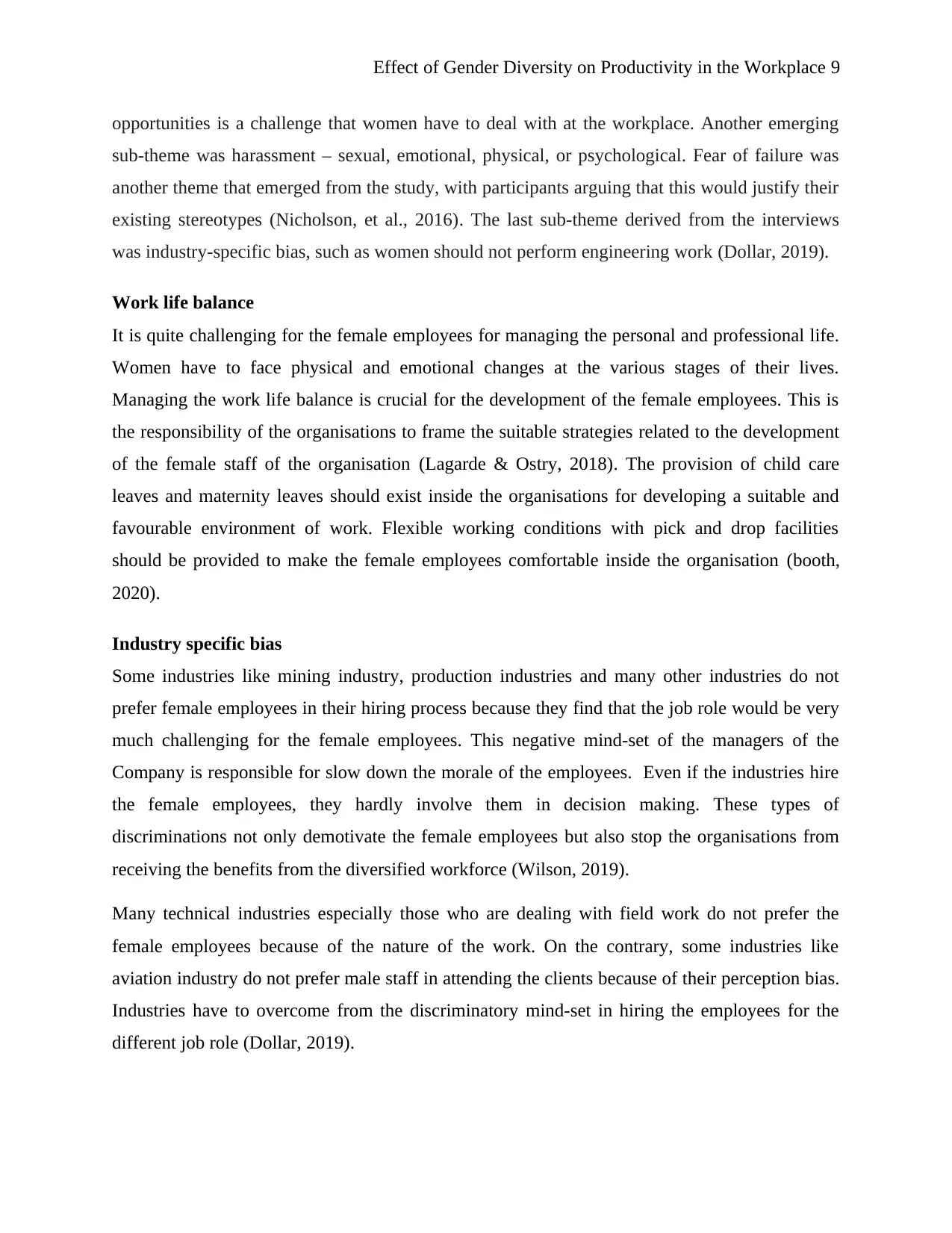
Effect of Gender Diversity on Productivity in the Workplace 9
opportunities is a challenge that women have to deal with at the workplace. Another emerging
sub-theme was harassment – sexual, emotional, physical, or psychological. Fear of failure was
another theme that emerged from the study, with participants arguing that this would justify their
existing stereotypes (Nicholson, et al., 2016). The last sub-theme derived from the interviews
was industry-specific bias, such as women should not perform engineering work (Dollar, 2019).
Work life balance
It is quite challenging for the female employees for managing the personal and professional life.
Women have to face physical and emotional changes at the various stages of their lives.
Managing the work life balance is crucial for the development of the female employees. This is
the responsibility of the organisations to frame the suitable strategies related to the development
of the female staff of the organisation (Lagarde & Ostry, 2018). The provision of child care
leaves and maternity leaves should exist inside the organisations for developing a suitable and
favourable environment of work. Flexible working conditions with pick and drop facilities
should be provided to make the female employees comfortable inside the organisation (booth,
2020).
Industry specific bias
Some industries like mining industry, production industries and many other industries do not
prefer female employees in their hiring process because they find that the job role would be very
much challenging for the female employees. This negative mind-set of the managers of the
Company is responsible for slow down the morale of the employees. Even if the industries hire
the female employees, they hardly involve them in decision making. These types of
discriminations not only demotivate the female employees but also stop the organisations from
receiving the benefits from the diversified workforce (Wilson, 2019).
Many technical industries especially those who are dealing with field work do not prefer the
female employees because of the nature of the work. On the contrary, some industries like
aviation industry do not prefer male staff in attending the clients because of their perception bias.
Industries have to overcome from the discriminatory mind-set in hiring the employees for the
different job role (Dollar, 2019).
opportunities is a challenge that women have to deal with at the workplace. Another emerging
sub-theme was harassment – sexual, emotional, physical, or psychological. Fear of failure was
another theme that emerged from the study, with participants arguing that this would justify their
existing stereotypes (Nicholson, et al., 2016). The last sub-theme derived from the interviews
was industry-specific bias, such as women should not perform engineering work (Dollar, 2019).
Work life balance
It is quite challenging for the female employees for managing the personal and professional life.
Women have to face physical and emotional changes at the various stages of their lives.
Managing the work life balance is crucial for the development of the female employees. This is
the responsibility of the organisations to frame the suitable strategies related to the development
of the female staff of the organisation (Lagarde & Ostry, 2018). The provision of child care
leaves and maternity leaves should exist inside the organisations for developing a suitable and
favourable environment of work. Flexible working conditions with pick and drop facilities
should be provided to make the female employees comfortable inside the organisation (booth,
2020).
Industry specific bias
Some industries like mining industry, production industries and many other industries do not
prefer female employees in their hiring process because they find that the job role would be very
much challenging for the female employees. This negative mind-set of the managers of the
Company is responsible for slow down the morale of the employees. Even if the industries hire
the female employees, they hardly involve them in decision making. These types of
discriminations not only demotivate the female employees but also stop the organisations from
receiving the benefits from the diversified workforce (Wilson, 2019).
Many technical industries especially those who are dealing with field work do not prefer the
female employees because of the nature of the work. On the contrary, some industries like
aviation industry do not prefer male staff in attending the clients because of their perception bias.
Industries have to overcome from the discriminatory mind-set in hiring the employees for the
different job role (Dollar, 2019).
⊘ This is a preview!⊘
Do you want full access?
Subscribe today to unlock all pages.

Trusted by 1+ million students worldwide
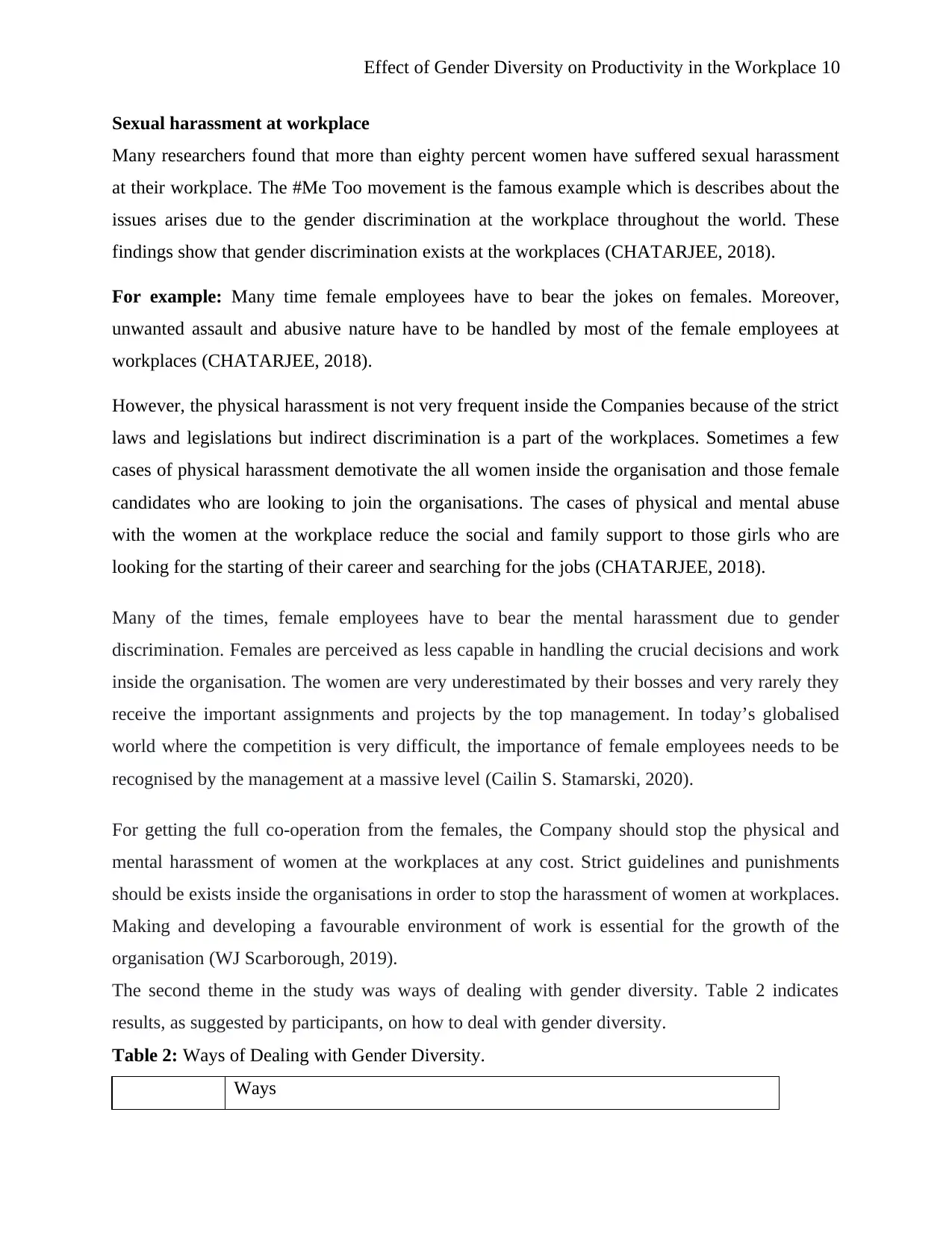
Effect of Gender Diversity on Productivity in the Workplace 10
Sexual harassment at workplace
Many researchers found that more than eighty percent women have suffered sexual harassment
at their workplace. The #Me Too movement is the famous example which is describes about the
issues arises due to the gender discrimination at the workplace throughout the world. These
findings show that gender discrimination exists at the workplaces (CHATARJEE, 2018).
For example: Many time female employees have to bear the jokes on females. Moreover,
unwanted assault and abusive nature have to be handled by most of the female employees at
workplaces (CHATARJEE, 2018).
However, the physical harassment is not very frequent inside the Companies because of the strict
laws and legislations but indirect discrimination is a part of the workplaces. Sometimes a few
cases of physical harassment demotivate the all women inside the organisation and those female
candidates who are looking to join the organisations. The cases of physical and mental abuse
with the women at the workplace reduce the social and family support to those girls who are
looking for the starting of their career and searching for the jobs (CHATARJEE, 2018).
Many of the times, female employees have to bear the mental harassment due to gender
discrimination. Females are perceived as less capable in handling the crucial decisions and work
inside the organisation. The women are very underestimated by their bosses and very rarely they
receive the important assignments and projects by the top management. In today’s globalised
world where the competition is very difficult, the importance of female employees needs to be
recognised by the management at a massive level (Cailin S. Stamarski, 2020).
For getting the full co-operation from the females, the Company should stop the physical and
mental harassment of women at the workplaces at any cost. Strict guidelines and punishments
should be exists inside the organisations in order to stop the harassment of women at workplaces.
Making and developing a favourable environment of work is essential for the growth of the
organisation (WJ Scarborough, 2019).
The second theme in the study was ways of dealing with gender diversity. Table 2 indicates
results, as suggested by participants, on how to deal with gender diversity.
Table 2: Ways of Dealing with Gender Diversity.
Ways
Sexual harassment at workplace
Many researchers found that more than eighty percent women have suffered sexual harassment
at their workplace. The #Me Too movement is the famous example which is describes about the
issues arises due to the gender discrimination at the workplace throughout the world. These
findings show that gender discrimination exists at the workplaces (CHATARJEE, 2018).
For example: Many time female employees have to bear the jokes on females. Moreover,
unwanted assault and abusive nature have to be handled by most of the female employees at
workplaces (CHATARJEE, 2018).
However, the physical harassment is not very frequent inside the Companies because of the strict
laws and legislations but indirect discrimination is a part of the workplaces. Sometimes a few
cases of physical harassment demotivate the all women inside the organisation and those female
candidates who are looking to join the organisations. The cases of physical and mental abuse
with the women at the workplace reduce the social and family support to those girls who are
looking for the starting of their career and searching for the jobs (CHATARJEE, 2018).
Many of the times, female employees have to bear the mental harassment due to gender
discrimination. Females are perceived as less capable in handling the crucial decisions and work
inside the organisation. The women are very underestimated by their bosses and very rarely they
receive the important assignments and projects by the top management. In today’s globalised
world where the competition is very difficult, the importance of female employees needs to be
recognised by the management at a massive level (Cailin S. Stamarski, 2020).
For getting the full co-operation from the females, the Company should stop the physical and
mental harassment of women at the workplaces at any cost. Strict guidelines and punishments
should be exists inside the organisations in order to stop the harassment of women at workplaces.
Making and developing a favourable environment of work is essential for the growth of the
organisation (WJ Scarborough, 2019).
The second theme in the study was ways of dealing with gender diversity. Table 2 indicates
results, as suggested by participants, on how to deal with gender diversity.
Table 2: Ways of Dealing with Gender Diversity.
Ways
Paraphrase This Document
Need a fresh take? Get an instant paraphrase of this document with our AI Paraphraser
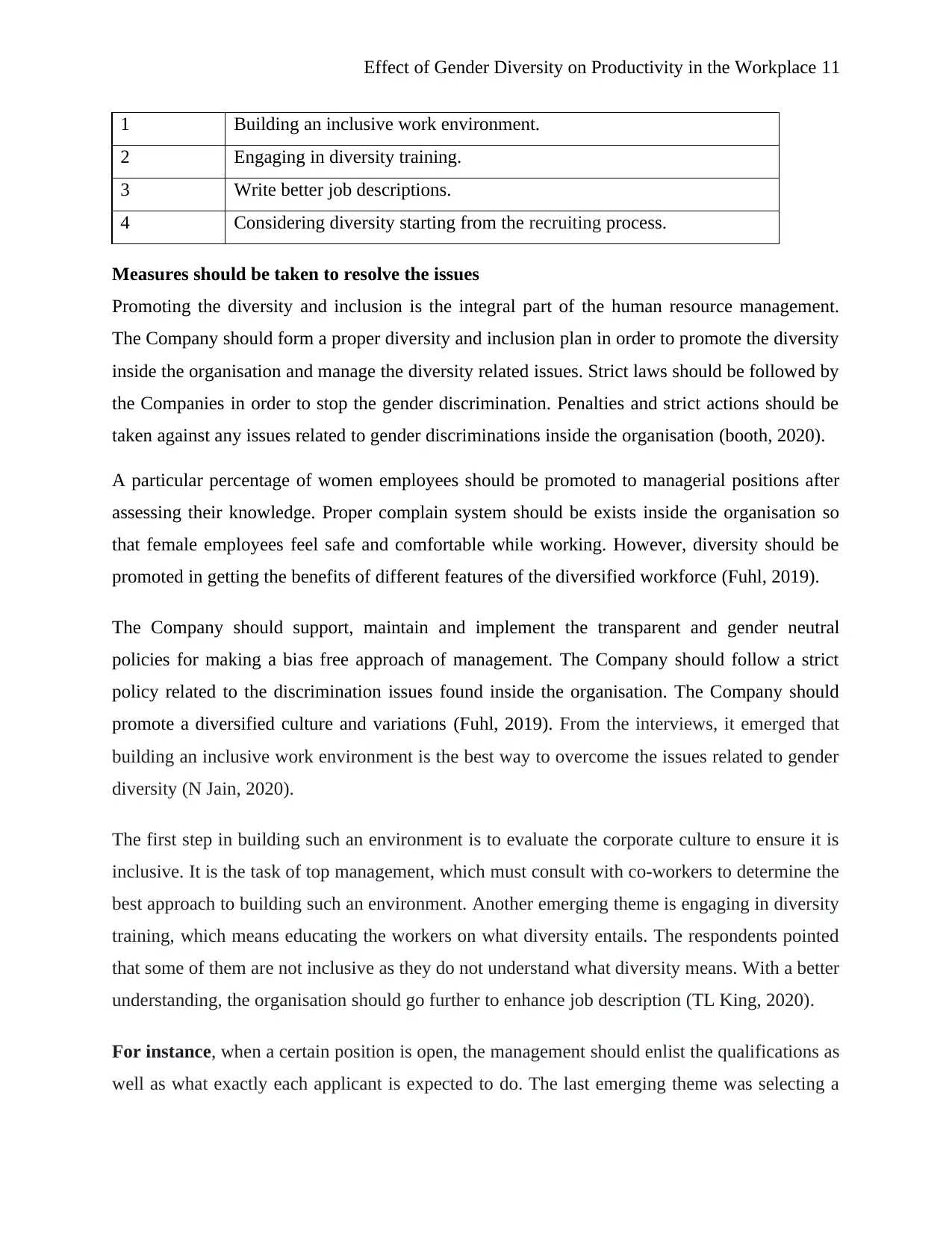
Effect of Gender Diversity on Productivity in the Workplace 11
1 Building an inclusive work environment.
2 Engaging in diversity training.
3 Write better job descriptions.
4 Considering diversity starting from the recruiting process.
Measures should be taken to resolve the issues
Promoting the diversity and inclusion is the integral part of the human resource management.
The Company should form a proper diversity and inclusion plan in order to promote the diversity
inside the organisation and manage the diversity related issues. Strict laws should be followed by
the Companies in order to stop the gender discrimination. Penalties and strict actions should be
taken against any issues related to gender discriminations inside the organisation (booth, 2020).
A particular percentage of women employees should be promoted to managerial positions after
assessing their knowledge. Proper complain system should be exists inside the organisation so
that female employees feel safe and comfortable while working. However, diversity should be
promoted in getting the benefits of different features of the diversified workforce (Fuhl, 2019).
The Company should support, maintain and implement the transparent and gender neutral
policies for making a bias free approach of management. The Company should follow a strict
policy related to the discrimination issues found inside the organisation. The Company should
promote a diversified culture and variations (Fuhl, 2019). From the interviews, it emerged that
building an inclusive work environment is the best way to overcome the issues related to gender
diversity (N Jain, 2020).
The first step in building such an environment is to evaluate the corporate culture to ensure it is
inclusive. It is the task of top management, which must consult with co-workers to determine the
best approach to building such an environment. Another emerging theme is engaging in diversity
training, which means educating the workers on what diversity entails. The respondents pointed
that some of them are not inclusive as they do not understand what diversity means. With a better
understanding, the organisation should go further to enhance job description (TL King, 2020).
For instance, when a certain position is open, the management should enlist the qualifications as
well as what exactly each applicant is expected to do. The last emerging theme was selecting a
1 Building an inclusive work environment.
2 Engaging in diversity training.
3 Write better job descriptions.
4 Considering diversity starting from the recruiting process.
Measures should be taken to resolve the issues
Promoting the diversity and inclusion is the integral part of the human resource management.
The Company should form a proper diversity and inclusion plan in order to promote the diversity
inside the organisation and manage the diversity related issues. Strict laws should be followed by
the Companies in order to stop the gender discrimination. Penalties and strict actions should be
taken against any issues related to gender discriminations inside the organisation (booth, 2020).
A particular percentage of women employees should be promoted to managerial positions after
assessing their knowledge. Proper complain system should be exists inside the organisation so
that female employees feel safe and comfortable while working. However, diversity should be
promoted in getting the benefits of different features of the diversified workforce (Fuhl, 2019).
The Company should support, maintain and implement the transparent and gender neutral
policies for making a bias free approach of management. The Company should follow a strict
policy related to the discrimination issues found inside the organisation. The Company should
promote a diversified culture and variations (Fuhl, 2019). From the interviews, it emerged that
building an inclusive work environment is the best way to overcome the issues related to gender
diversity (N Jain, 2020).
The first step in building such an environment is to evaluate the corporate culture to ensure it is
inclusive. It is the task of top management, which must consult with co-workers to determine the
best approach to building such an environment. Another emerging theme is engaging in diversity
training, which means educating the workers on what diversity entails. The respondents pointed
that some of them are not inclusive as they do not understand what diversity means. With a better
understanding, the organisation should go further to enhance job description (TL King, 2020).
For instance, when a certain position is open, the management should enlist the qualifications as
well as what exactly each applicant is expected to do. The last emerging theme was selecting a
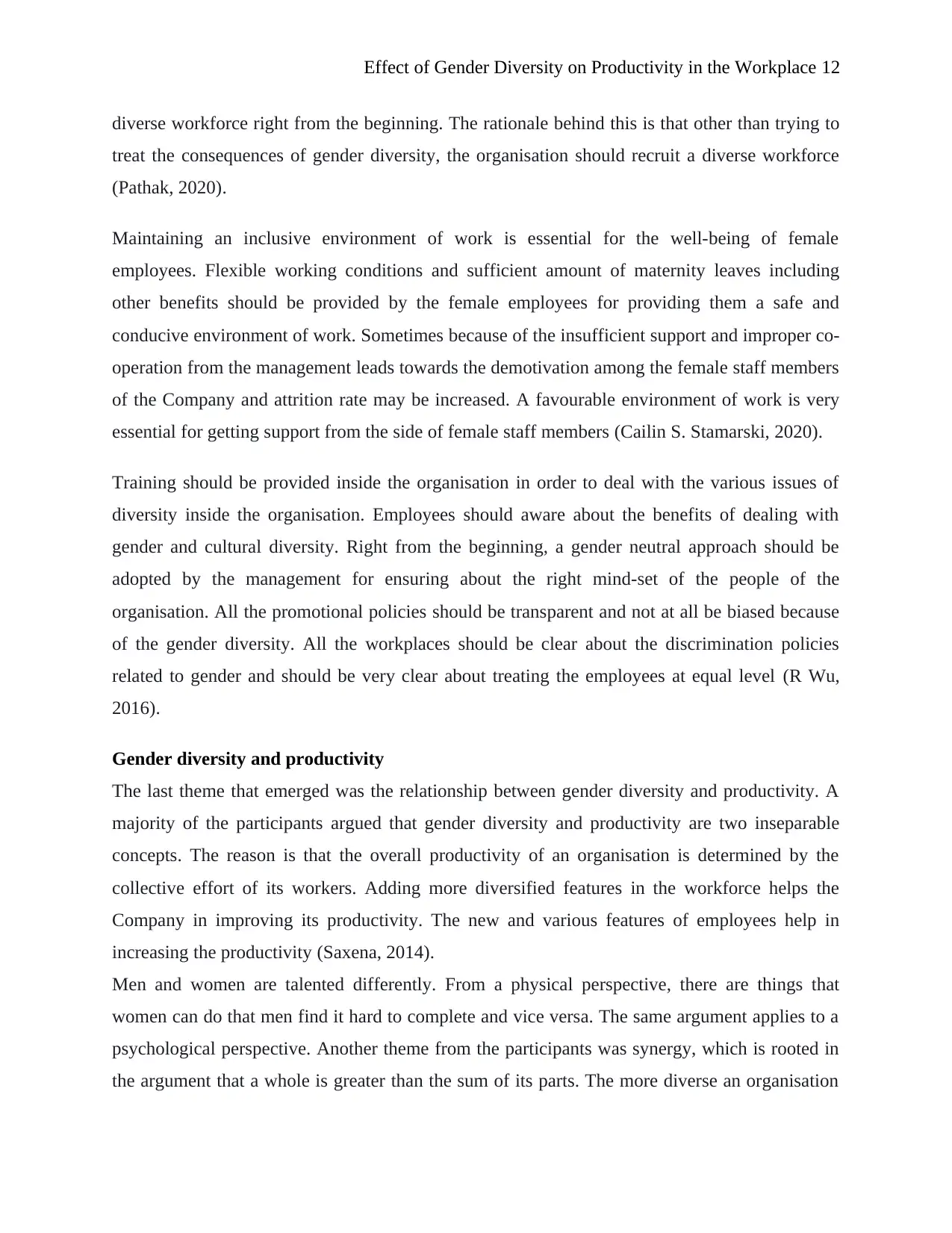
Effect of Gender Diversity on Productivity in the Workplace 12
diverse workforce right from the beginning. The rationale behind this is that other than trying to
treat the consequences of gender diversity, the organisation should recruit a diverse workforce
(Pathak, 2020).
Maintaining an inclusive environment of work is essential for the well-being of female
employees. Flexible working conditions and sufficient amount of maternity leaves including
other benefits should be provided by the female employees for providing them a safe and
conducive environment of work. Sometimes because of the insufficient support and improper co-
operation from the management leads towards the demotivation among the female staff members
of the Company and attrition rate may be increased. A favourable environment of work is very
essential for getting support from the side of female staff members (Cailin S. Stamarski, 2020).
Training should be provided inside the organisation in order to deal with the various issues of
diversity inside the organisation. Employees should aware about the benefits of dealing with
gender and cultural diversity. Right from the beginning, a gender neutral approach should be
adopted by the management for ensuring about the right mind-set of the people of the
organisation. All the promotional policies should be transparent and not at all be biased because
of the gender diversity. All the workplaces should be clear about the discrimination policies
related to gender and should be very clear about treating the employees at equal level (R Wu,
2016).
Gender diversity and productivity
The last theme that emerged was the relationship between gender diversity and productivity. A
majority of the participants argued that gender diversity and productivity are two inseparable
concepts. The reason is that the overall productivity of an organisation is determined by the
collective effort of its workers. Adding more diversified features in the workforce helps the
Company in improving its productivity. The new and various features of employees help in
increasing the productivity (Saxena, 2014).
Men and women are talented differently. From a physical perspective, there are things that
women can do that men find it hard to complete and vice versa. The same argument applies to a
psychological perspective. Another theme from the participants was synergy, which is rooted in
the argument that a whole is greater than the sum of its parts. The more diverse an organisation
diverse workforce right from the beginning. The rationale behind this is that other than trying to
treat the consequences of gender diversity, the organisation should recruit a diverse workforce
(Pathak, 2020).
Maintaining an inclusive environment of work is essential for the well-being of female
employees. Flexible working conditions and sufficient amount of maternity leaves including
other benefits should be provided by the female employees for providing them a safe and
conducive environment of work. Sometimes because of the insufficient support and improper co-
operation from the management leads towards the demotivation among the female staff members
of the Company and attrition rate may be increased. A favourable environment of work is very
essential for getting support from the side of female staff members (Cailin S. Stamarski, 2020).
Training should be provided inside the organisation in order to deal with the various issues of
diversity inside the organisation. Employees should aware about the benefits of dealing with
gender and cultural diversity. Right from the beginning, a gender neutral approach should be
adopted by the management for ensuring about the right mind-set of the people of the
organisation. All the promotional policies should be transparent and not at all be biased because
of the gender diversity. All the workplaces should be clear about the discrimination policies
related to gender and should be very clear about treating the employees at equal level (R Wu,
2016).
Gender diversity and productivity
The last theme that emerged was the relationship between gender diversity and productivity. A
majority of the participants argued that gender diversity and productivity are two inseparable
concepts. The reason is that the overall productivity of an organisation is determined by the
collective effort of its workers. Adding more diversified features in the workforce helps the
Company in improving its productivity. The new and various features of employees help in
increasing the productivity (Saxena, 2014).
Men and women are talented differently. From a physical perspective, there are things that
women can do that men find it hard to complete and vice versa. The same argument applies to a
psychological perspective. Another theme from the participants was synergy, which is rooted in
the argument that a whole is greater than the sum of its parts. The more diverse an organisation
⊘ This is a preview!⊘
Do you want full access?
Subscribe today to unlock all pages.

Trusted by 1+ million students worldwide
1 out of 18
Related Documents
Your All-in-One AI-Powered Toolkit for Academic Success.
+13062052269
info@desklib.com
Available 24*7 on WhatsApp / Email
![[object Object]](/_next/static/media/star-bottom.7253800d.svg)
Unlock your academic potential
Copyright © 2020–2025 A2Z Services. All Rights Reserved. Developed and managed by ZUCOL.





